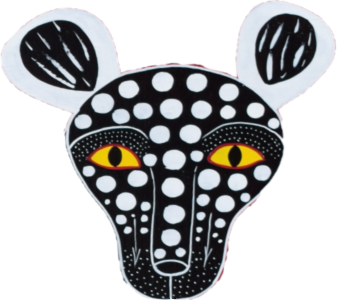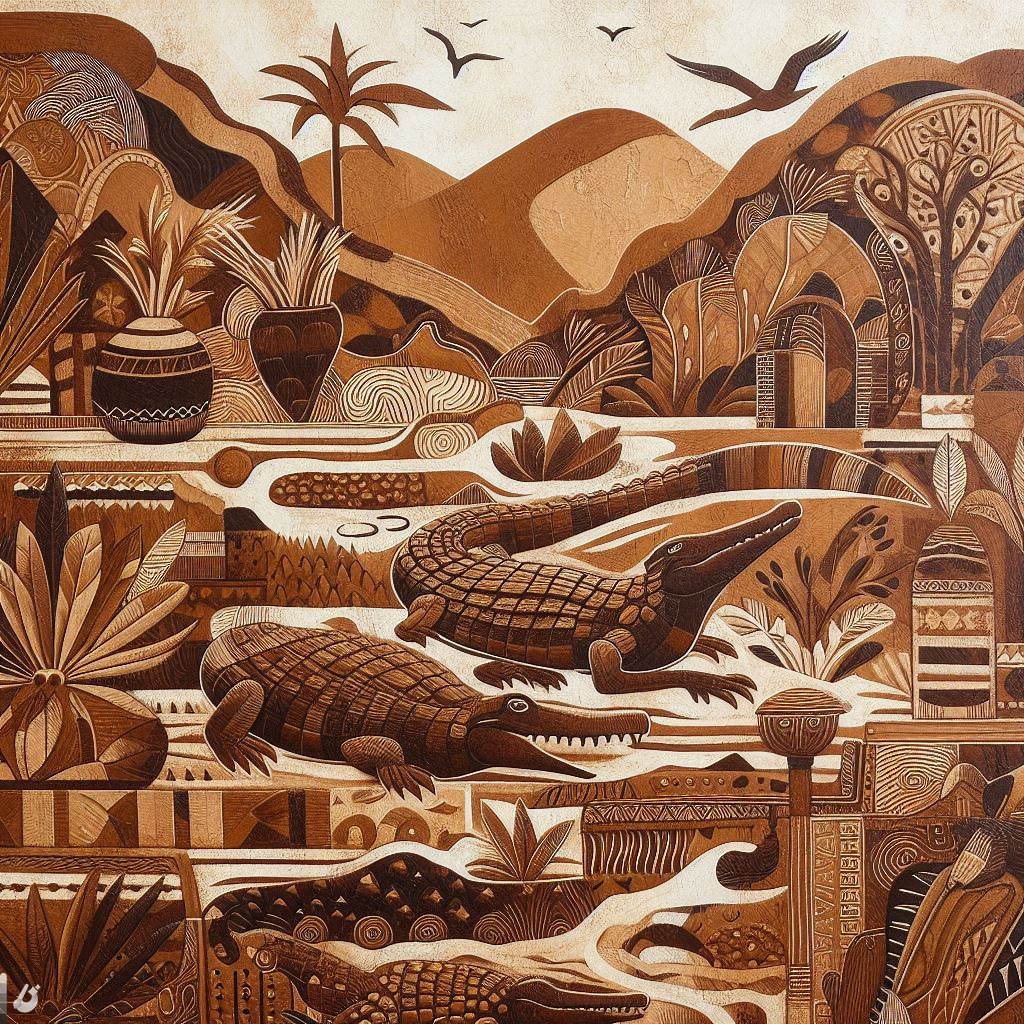July 23, 2023
Introduction:
African art has a rich history that stretches back thousands of years, reflecting the continent's diverse cultures, beliefs, and wildlife. Among the various animals commonly depicted in African paintings, the crocodile holds a special place. These formidable reptiles have been a subject of fascination and reverence in African societies, leading to their frequent appearance in artworks. This article explores the reasons why crocodiles feature prominently in African paintings and the symbolic significance they carry.
- Ancient Symbolism:
The crocodile's association with African art can be traced back to ancient times when civilizations revered nature and animals. In many African cultures, the crocodile symbolizes both positive and negative attributes. On one hand, it represents strength, power, and survival, as crocodiles are among the oldest and most resilient creatures on Earth. Their ability to adapt and endure in harsh environments has earned them admiration and respect.
- Guardians of Water:
In many regions of Africa, water is a precious and life-sustaining resource. Crocodiles, being semi-aquatic animals, inhabit rivers, lakes, and swamps, making them an integral part of the water ecosystems. African communities that rely on these water sources for their livelihoods see crocodiles as guardians or protectors of these essential water bodies. In paintings, crocodiles may be depicted alongside humans or other animals, symbolizing their role as guardians of water and the delicate balance of nature.
- Spiritual and Cultural Significance:
In some African societies, crocodiles hold spiritual significance and are believed to possess mystical powers. They are often associated with deities or ancestral spirits, and rituals may be conducted to appease or seek protection from these creatures. The crocodile's mysterious and elusive nature adds to its mythical aura, making it a compelling subject for artists to portray in their work.
- Lessons from Nature:
African paintings often carry moral and educational messages, using animals as symbols to convey valuable lessons. The crocodile's behavior in the wild, such as patience, stealth, and strategic hunting, is often depicted to impart life lessons to the audience. It serves as a reminder of the delicate balance between humans and the natural world and the importance of understanding and respecting the environment.
- Connection to Creation Myths:
In some African creation myths, crocodiles play a pivotal role. They are believed to be primordial beings associated with the formation of the world or significant events in the universe's history. Their depiction in art connects communities to their ancestral origins and reinforces their identity and cultural heritage.
- Power and Authority:
In certain African societies, leaders and rulers are often associated with symbols of power and authority found in nature. The crocodile's commanding presence and fearsome reputation as a predator make it a fitting representation of leadership and sovereignty. Depicting crocodiles in regal or majestic poses in paintings may symbolize the strength and dominance of those in positions of authority.
- Ritual and Ceremonial Art:
Crocodile imagery is often prevalent in African ritual and ceremonial art. From masks to sculptures and wall paintings, crocodile motifs are used in traditional ceremonies to invoke protective spirits, celebrate important events, or mark significant rites of passage. These artworks act as conduits for spiritual communication and play a central role in the cultural practices of many African communities.
- Environmental Concerns:
In contemporary African art, the representation of crocodiles may also serve as a commentary on environmental issues. With increasing threats to their natural habitats and populations, artists may use their work to raise awareness about conservation efforts, habitat preservation, and the need for sustainable practices. By portraying crocodiles in vulnerable or endangered situations, artists aim to draw attention to the broader challenges faced by African wildlife and ecosystems.
- Influence of Folklore and Stories:
Crocodiles feature prominently in African folklore and traditional stories, often portrayed as both cunning and wise or occasionally as menacing and dangerous creatures. Artists may draw inspiration from these tales and incorporate them into their paintings, providing a visual narrative that resonates with cultural heritage and storytelling traditions.
- Artistic Aesthetics:
Beyond symbolism and cultural significance, crocodiles' unique anatomy and distinctive features offer artists an exciting subject to explore artistically. Their scaly skin, sharp teeth, and elongated bodies present captivating visual elements that can be creatively depicted in various artistic styles and mediums.
- Cross-Cultural Exchange:
African art has a profound impact on the global art scene, inspiring artists from diverse backgrounds. Crocodiles' portrayal in African paintings may transcend geographical boundaries and find appreciation in art collectors and enthusiasts worldwide. This cross-cultural exchange serves as a bridge, fostering understanding and appreciation of African art and its cultural roots.
- Signifying Life and Death:
Crocodiles are often associated with the cycle of life and death in African art. Their ability to both thrive in water and move on land links them to the concept of dual existence - bridging the realms of the living and the dead. In certain African cosmologies, crocodiles are seen as intermediaries between the spirit world and the physical world, making them potent symbols of transition and transformation.
- Protecting Ancestral Burial Sites:
In some African cultures, crocodiles are believed to protect ancestral burial sites, where the remains of their forefathers rest. It is thought that the spirits of the deceased take the form of these powerful reptiles, guarding the resting places of their descendants. African paintings may portray crocodiles in this context, signifying the spiritual guardianship of sacred lands.
- Tribal Identity and Totems:
For certain African tribes, animals like crocodiles are considered totems, representing a clan or tribal identity. These totems are an essential part of the community's cultural heritage and are often depicted in art to symbolize kinship, unity, and shared ancestry. Crocodile motifs in paintings reinforce the sense of belonging and pride within the tribe.
- Art as a Form of Communication:
African paintings are not solely for aesthetic purposes; they often serve as a means of communication within communities. Crocodile imagery can convey important messages, such as warnings about dangers in certain areas, narratives about local myths and legends, or historical events related to crocodiles. The visual language of art allows for the transmission of information and knowledge across generations.
- Representing the Wild and Untamed:
Crocodiles embody the wild and untamed aspects of nature. In African paintings, they may symbolize the uncontrollable forces of the natural world, reminding viewers of the delicate balance between humans and the environment. The presence of crocodiles in art can act as a reminder of the need for respect and caution when interacting with wildlife.
- Connection to Water Spirits:
In some African belief systems, water bodies are believed to be inhabited by spirits. Crocodiles, being creatures of the water, are seen as vessels for these water spirits. In artistic representations, crocodiles may be depicted with spiritual adornments or symbols, reinforcing their connection to the ethereal world.
- Incorporating Crocodile Imagery in Ceremonies:
Crocodile-inspired art plays a significant role in various African ceremonies. For example, during initiation rites, young men may be adorned with body paint resembling crocodile scales to symbolize their passage into adulthood and their preparedness to face life's challenges.
Conclusion:
Crocodiles hold multifaceted meanings in African paintings, woven into the cultural fabric of the continent's diverse societies. From their symbolic representation of power and guardianship to their significance in spiritual beliefs and environmental consciousness, crocodiles continue to occupy a prominent place in African art. Whether as a source of inspiration, a connection to ancestral traditions, or a visual narrative of cultural heritage, crocodile imagery remains a timeless and evocative element in the vibrant tapestry of African art.
At www.tingatingaart.com, we are passionate about showcasing the vibrant and captivating world of African wildlife through the eyes of talented artists.
Our collection celebrates the magnificence of Africa's fauna, featuring a wide range of animals, including lions, elephants, giraffes, zebras, leopards, and, of course, crocodiles, among many others. Each painting is a masterpiece that embodies the spirit and symbolism of these remarkable creatures, bringing to life the essence of African landscapes and cultures.
Tinga Tinga Art is committed to supporting and promoting African artists, ensuring that their unique perspectives and artistic expressions reach a global audience. Our platform provides a bridge between talented artists and art enthusiasts worldwide, fostering cross-cultural appreciation and understanding.
Whether you are an avid art collector, a wildlife enthusiast, or someone seeking to infuse your space with the vibrant spirit of Africa, our gallery of African wildlife paintings has something special to offer. Each piece is an homage to the continent's natural beauty and the intricate relationships between humans and the animal kingdom.
We take pride in offering authentic, high-quality African artworks that reflects the heart and soul of Africa. Every purchase made on our website directly supports the artists and the communities they represent, enabling sustainable and ethical partnerships.
Browse our diverse selection of African wildlife paintings, each brushstroke telling a story of resilience, majesty, and the interconnectedness of life. Join us in preserving and celebrating the extraordinary wildlife of Africa through art.
Thank you for choosing Tinga Tinga Art as your destination for African wildlife paintings. Together, let us embark on a journey that celebrates the magnificence of Africa's wildlife and the enduring legacy of its artistic traditions.


